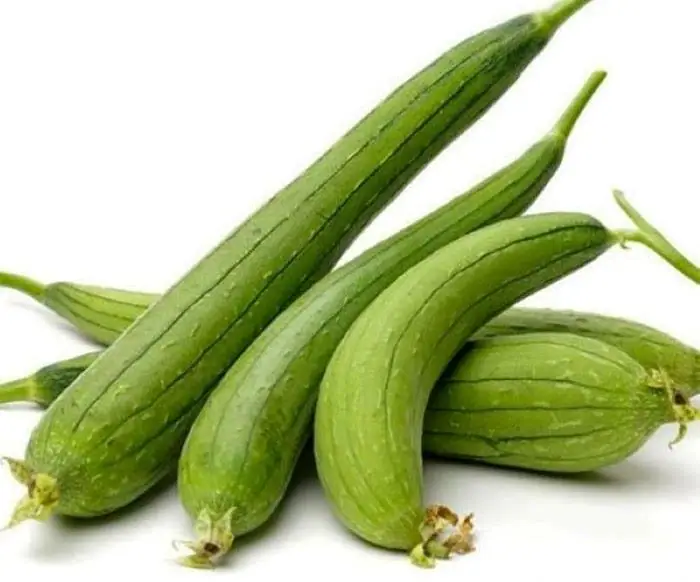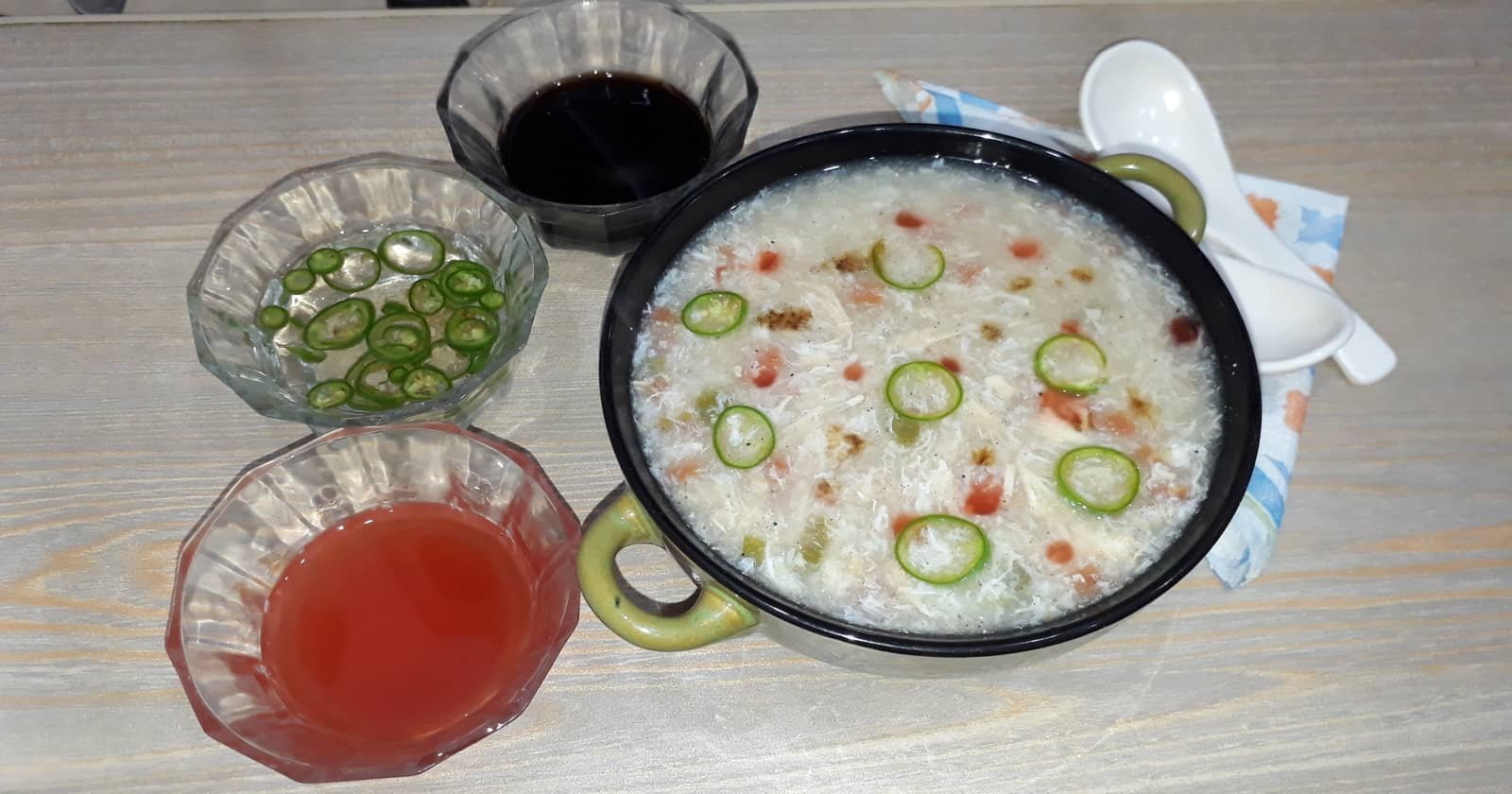Today, I will take you on a culinary journey and share a delightful Ridge Gourd Recipe with you. Before we dive into the recipe, let’s take a moment to understand what ridge gourd is.
Ridge Gourd Curry refers to Turai ki Sabji, an unassuming yet flavorful dish essential to the Indian culinary landscape. This simple, everyday side dish brims with health benefits and delivers an easy-to-make, scrumptious eating experience.
Whether you’re venturing into Indian cooking or eager to try a novel culinary delight, ridge gourd vegetable is a superb place to begin your journey.
What is Ridge Gourd?
Ridge gourd, scientifically known as Luffa acutangula, is a popular vegetable that belongs to the cucumber family. It goes by various names across different regions, such as turai in Hindi and Urdu, turiya in Gujarati and Marathi, beerakaya in Telugu, peerkangai in Tamil, and heeray kayi in Kannada.
This is a tropical vegetable widely used across the Indian subcontinent. ‘Sabji’ or ‘Sabzi’ is a term used across India to describe a dish of cooked vegetables, usually in the form of a curry or stir-fry. Hence, ‘turai ki sabji’ translates to a ‘ridge gourd curry’ or ‘ridge gourd stir-fry.’
What makes the ridge gourd dish unique is its balance of flavors. It has a mildly sweet undertone, which comes from the ridge gourd itself, and the spices add a savory edge, making it a balanced and delightful dish. The texture is a mix of soft (from the cooked gourd) and crunchy (from the sautéed spices), giving an interesting mouthfeel.
Beyond its flavor, ridge gourd is also loved for its health benefits. It’s light, nutritious, and easy to digest, making it a popular choice for a healthy, home-cooked meal.
Your Summer Ally: Ridge Gourd
Have you ever considered the everyday, modest vegetables you’ve been overlooking? ‘Ridge Gourd’ might be one of those humble yet powerful vegetables you’ve been underrating all this time.
Regarded as one of the summer’s treasures, ridge gourd is a vegetable packed with fiber and oozes nutrition. This superstar is light on the stomach, thus a blessing for those who struggle with digestion.
But wait! Did you know this humble vegetable goes by many names across the globe? It’s indeed fascinating. It’s also referred to as the Chinese okra, Luffa acutangula, or sponge gourd. In Hindi, ridge gourd is also known as tori, kali tori, or ghiya tori.
History of Ridge Gourd
Origins of Ridge Gourd
The origin of ridge gourd can be traced back to ancient times when traditional Indian cooking techniques were developed. Ridge gourds are believed to have originated in Southeast Asia before making their way to India through trade routes centuries ago.
Since then, they have become an integral part of Indian cuisine due to their versatility, mild flavor profile, and impressive health benefits. The combination of ridge gourds’ unique texture and ability to absorb flavors makes them a favorite ingredient in various regional recipes.
Ridge Gourd Recipe in Indian Cuisine
Ridge gourd recipe holds an esteemed position in Indian cuisine, where it is embraced for its versatility and culinary potential. From the turai ki sabji of North India to the peerkangai kootu of South India and the jhinge posto of East India, this vegetable gracefully adapts to various regional flavors and cooking techniques.
In India, ridge gourd is commonly referred to as “turai” or “tori.” The vegetable has been embraced for its unique taste, texture, and adaptability in cooking. Its name, “turai ki sabji,” indicates its association with being a popular vegetable for preparing delicious curries or stir-fries.
Among the diverse assortment of ridge gourd dishes, ridge gourd holds a special place in the hearts of Indians for its homely, comforting flavors.
Nutrition Facts
Vitamins in Ridge Gourd
Ridge gourd is a treasure trove of essential vitamins like Vitamin A, Vitamin C, and Vitamin B9 (Folate). These vitamins are crucial in bolstering immunity, maintaining radiant skin, and promoting cell growth.
Minerals in Ridge Gourd
Furthermore, ridge gourd contains minerals such as Iron, Magnesium, and Manganese. These minerals are crucial in promoting overall health and ensuring proper bodily functions.
Health Benefits
With its high fiber and high-water content, low-calorie count, and rich nutritional profile, ridge gourd is a health enthusiast’s delight. It aids in digestion and weight loss and even regulates blood sugar levels, making it an ideal dietary addition.
The Ridge Gourd Recipe
Let’s take a trip down to my kitchen, where we’ll delve into the secrets of this authentic ridge gourd recipe. Today’s protagonist is a fresh ridge gourd plucked straight from my garden.
Interestingly, this vegetable comes in two distinct types – one with a sleek, smooth surface and another with a ridged surface, offering you the versatility of choice for your recipes. Our focus today will be the smooth variant.
Here’s how we conjure up the magic:
Preparing for Cooking
Choosing the Right Ridge Gourd
Selecting the proper ridge gourd for your dish is crucial. Look for firm gourds with a vibrant green hue and devoid of blemishes or dark spots.
Essential Ingredients of Ridge Gourd Recipe
Apart from ridge gourd, you’ll need onions, ginger, garlic, green chilies, tomatoes, black cumin powder, turmeric powder, red chili powder, salt, coriander leaves, and fresh green chilies. Each ingredient contributes to a unique flavor profile, transforming the ridge gourd into a mouthwatering feast.
How to Cook Ridge Gourd?
Preparing the Ridge Gourd
Start by weighing out ½ kg of ridge gourd. Make sure to wash the ridge gourd thoroughly under running water to remove any dust or impurities.
While peeling, do not peel off too much – remember, under its skin resides a horde of nutritional elements we don’t want to lose.
After peeling, chop it into circular pieces, and feel free to adjust the thickness to your liking.
Making the Masala
Now we move on to the dry masala preparation. Pour half a cup of cooking oil into the wok, and heat it slightly. Now, it’s time to add 2 tsp of ginger-garlic paste. Sauté this lightly, ensuring the raw smell dissipates. Keep the flame low at this stage.
Next in line are finely chopped onions. Sauté these until tender. Remember, we aren’t aiming for a golden-brown hue.
Adding Ridge Gourd and Spices
At this stage, add the sliced ridge gourd and chopped tomatoes. Now let’s spice things up with:
- Salt: 1 tsp or as per taste
- Turmeric powder: ½ tsp
- Red chili powder: ½ tsp
Give all the ingredients a good mix. Cover the wok and let it simmer for 15 to 20 minutes on low heat.
Ridge gourd naturally releases water during cooking. This water is the secret ingredient that makes all the flavors blend perfectly.
Wrapping Up
After about 18 minutes, unveil the wok. The water should have evaporated by this time, and the ridge gourd should be tender.
Sprinkle ½ tsp of cumin powder over it for that extra kick of flavor. Sauté it for a minute more.
You’ll notice a wonderful aroma wafting from the dish at this stage. Now your delightful ridge gourd is ready to serve!
Serving Time
Now comes the most exciting part: serving! Dish it out and garnish with freshly chopped coriander leaves and sliced green chilies. Now, doesn’t that look tempting?
There you have it, folks – a simple, nourishing, and utterly delicious ridge gourd recipe for you to try at home. Enjoy this fantastic journey of flavors and aroma!
Serving Suggestions
Ridge gourd curry or turai ki sabji can be served with hot rotis or steamed rice. A side of tangy pickles or cooling yogurt can complement the dish perfectly.
Recipe Card

Ridge Gourd Recipe
Ingredients
- ½ kg fesh ridge gourd (turai or tori)
- 125 grams onion
- 125 grams tomato
- 2 tsp ginger-garlic paste
- 1 tsp salt (or to taste)
- ½ tsp turmeric powder
- ½ tsp red chili powder
- ½ tsp black cumin powder
- ½ cup cooking oil
- fresh coriander leaves and green chilies for garnishing
Instructions
Preparing the Ridge Gourd
- Start by washing the ridge gourd thoroughly under running water to remove dust or impurities.

- While peeling, do not peel off too much – remember, under its skin resides a horde of nutritional elements we don't want to lose.

- After peeling, chop it into circular pieces, and feel free to adjust the thickness to your liking.

Making the Masala
- Pour half a cup of cooking oil into the wok, and heat it slightly. Add 2 tsp of ginger-garlic paste. Sauté it lightly, ensuring the raw smell dissipates. Keep the flame low at this stage.

- Next, add finely chopped onions. Sauté these until tender. Remember, we aren't aiming for a golden-brown hue.

Adding Ridge Gourd and Spices
- At this stage, add the sliced ridge gourd and chopped tomatoes.

- Now let's spice things up with salt, turmeric powder, and red chili powder.

- Give all the ingredients a good mix. Cover the wok and let it simmer for 15 to 20 minutes on low heat.Ridge gourd naturally releases water during cooking. This water is the secret ingredient that makes all the flavors blend perfectly.

Wrapping Up
- After about 18 minutes, unveil the wok. The water should have evaporated by this time, and the ridge gourd should be tender.

- Sprinkle ½ tsp of cumin powder over it for that extra kick of flavor. Sauté it for a minute more.You'll notice a wonderful aroma wafting from the dish at this stage. Now your delightful ridge gourd is ready to serve!

Garnishing and Serving
- Now comes the most exciting part: serving! Dish it out and garnish with freshly chopped coriander leaves and sliced green chilies.A simple, nourishing, and utterly delicious ridge gourd curry is ready for you.Ridge gourd curry or turai ki sabji can be served with hot rotis or steamed rice. A side of tangy pickles or cooling yogurt can complement the dish perfectly.

Tips for Buying, Storing, and Cooking with Fresh Ridge Gourd
How to select fresh and tender ridge gourds at the market
When selecting the perfect ridge gourd for your dish, there are a few key factors to consider. Look for ridge gourds that are firm, smooth-skinned, and free from any blemishes or soft spots. The skin should have a vibrant green color, indicating its freshness.
Avoid ridge gourds that feel too hard or too soft when gently squeezed. Additionally, pay attention to the size of the ridge gourd.
Small to medium-sized ones are generally more tender and flavorful than larger ones. The ideal length of a ridge gourd is around 6-8 inches, as longer ones become fibrous and less enjoyable.
For added quality assurance, try sourcing your ridge gourds from local farmers’ markets or organic stores, where they are likely to be fresher and pesticide-free. You will lay the foundation for a delectable ridge gourd dish by selecting fresh and tender ridge gourds at the market.
Proper storage techniques to maintain the freshness
Proper storage is crucial to ensure that your freshly purchased ridge gourds stay fresh and retain their nutritional value for as long as possible. It’s best not to wash them before storing them since moisture can lead to spoilage. Instead, store them unwashed in a cool, dry place like a refrigerator’s vegetable crisper drawer.
If you have any leftover pieces of cut ridge gourd, wrap them tightly in plastic wrap or place them in an airtight container before refrigerating. This will prevent them from drying out quickly or absorbing unwanted odors from other foods in the fridge.
Consume stored ridge gourds within three to four days for optimal taste and texture. Remember that fresher ingredients yield superior results when cooking your delectable turai ki sabji.
Cooking tips to enhance the flavor and texture
Creating the perfect ridge gourd dish is an art that requires attention to detail, a dash of patience, and a lot of love. Here are some tips to ensure your ridge gourd is a flavorful success:
- Proper Cleaning and Peeling: Make sure to wash the ridge gourd thoroughly under running water to remove any dust or impurities. While peeling do not peel off too much while peeling, as some of the nutrients lie beneath the skin.
- Cook on Low Heat: Cooking ridge gourd on a low flame ensures it cooks evenly and doesn’t become mushy. High heat can cause it to cook unevenly and may burn the spices.
- Right Balance of Spices: The magic of Indian cuisine lies in the harmony of flavors. Add your spices carefully, ensuring none overpower the others. Each spice should contribute to the dish’s overall flavor without stealing the show.
- Cooking Time: Overcooking ridge gourd can become mushy and lose its flavor. Cook it until it is just soft enough to pierce with a fork.
- Sautéing Onions: Sauté onions until tender (not golden brown). This brings out the sweetness in the onions, adding another layer of flavor to the dish.
Keeping these tips in mind while cooking will help you prepare a delicious and perfect ridge gourd every time!
Common Mistakes in Cooking Ridge Gourd
While cooking ridge gourd might seem easy, some common mistakes can affect the outcome. Here are some pitfalls to avoid while preparing this dish:
- Over-peeling the Ridge Gourd: Many people peel off too much from the ridge gourd, losing much of the nutrients beneath the skin. Light peeling is more than enough to prepare the vegetable for cooking.
- Overcooking the Ridge Gourd: Overcooking the ridge gourd can make your vegetable mushy and unappetizing. Cook the ridge gourd until it’s just tender. It should still hold its shape and have a slight bite to it.
- Adding too many spices: The beauty of ridge gourd is in its simplicity. Loading it with too many spices can overpower the delicate flavor of the ridge gourd. Stick to the basic spices like turmeric, coriander, and cumin for the best results.
- Not cooking on low heat: Cooking ridge gourd on high heat can cause the vegetable to cook unevenly. It might also burn the spices, leading to a bitter taste. Always cook this dish on low to medium heat.
- Not sautéing the onions properly: They must be sautéed until tender (not golden brown). This caramelizes them and brings out their sweetness, which adds a depth of flavor to the turai ki sabji.
- Not washing the Ridge Gourd properly: The ridge gourd should be washed thoroughly to remove residual dirt or pesticides. This step is necessary to avoid a gritty texture and unwanted flavors in your dish.
Avoiding these common mistakes can help ensure your ridge gourd is flavorful and perfectly cooked.
Lesser-known Facts about Ridge Gourd
Ridge Gourd, as a versatile ingredient in other cuisines around the world
Ridge gourd, known by various names such as sponge gourd or luffa, extends its culinary influence far beyond the borders of India. This humble vegetable has found its way into different international cuisines, showcasing its versatility and adaptability.
One such example is Thai cuisine, where ridge gourd is highly regarded for its unique crunchy texture and ability to retain its shape even when cooked at high heat.
Ridge Gourd used in Thai cuisine for its crunchy texture in stir-fries
In Thailand, ridge gourd is commonly used in stir-fries to add a delightful crunch to dishes. The mild flavor of ridge gourd complements well with the vibrant Thai spices and sauces typically used in these preparations.
It can be sliced thin or julienned before being quickly cooked over high heat with other vegetables, meat, or seafood. The result is an irresistible blend of textures, where the tender yet crisp ridge gourd adds a refreshing bite to the dish.
Ridge Gourd is a popular vegetable in Middle Eastern dishes like Mahshi.
Beyond Asia, ridge gourd has also gained popularity in Middle Eastern cuisines. One such instance is seen in Mahshi, an Arabic dish where hollowed-out ridge gourd is stuffed with flavorful fillings like rice or minced meat before being baked or stewed. The mild taste of ridge gourd allows it to absorb the rich flavors from the stuffing and cooking liquid effortlessly while retaining its firmness.
This combination creates a delectable dish that showcases both the versatility of this vegetable and the artistry of Middle Eastern culinary traditions. By exploring these lesser-known facts about ridge gourd vegetables, we discover that they transcend borders and cultures to become an ingredient valued for their taste and texture.
Whether adding a satisfying crunch to Thai stir-fries or being stuffed with delicious fillings in Middle Eastern dishes like Mahshi, ridge gourd is a versatile and delightful addition to various cuisines worldwide. Embracing the versatility of ridge gourd allows us to appreciate its unique qualities and unlock new culinary possibilities beyond traditional Indian recipes.
FAQs about Ridge Gourd
How to remove bitterness from ridge gourd after cooking?
The bitterness in the ridge gourd might be due to the gourd’s maturity. Once cooked, it’s difficult to completely remove the bitterness. However, adding ingredients like sugar, tamarind or coconut milk can help balance the bitterness to some extent.
How to store Ridge Gourd in the Fridge?
For best results, ridge gourd should be stored unwashed in a plastic bag in the refrigerator’s vegetable drawer. Ensure that the gourd is dry before storing it, as moisture can lead to early spoilage.
How to cut Ridge Gourd?
The ridge gourd can be cut easily with a sharp knife. Start by cutting off the ends, then slice lengthwise to cut the gourd open. You can then remove the seeds and slice or dice them as per your ridge gourd recipe requirements.
How to clean Ridge Gourd?
To clean the ridge gourd, wash it under running water to remove any dirt or residue. Then, using a peeler or a knife, scrape off the ridged skin, making sure to remove any prickly parts.
How to peel Ridge Gourd?
Peeling a ridge gourd is simple. Use a standard vegetable peeler or a sharp knife, starting from one end and moving towards the other. Make sure to remove all the tough, ridged skin for a smoother texture in your dishes. Do not peel off too much while peeling, as some of the nutrients lie beneath the skin.













